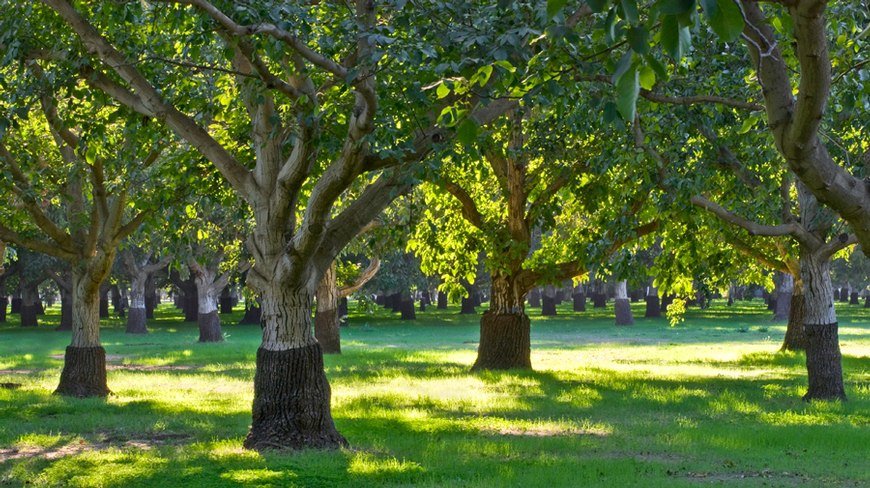Grower assessments have resulted in activities that have led to the tremendous economic growth of the California Walnut Industry. Even though production keeps growing, last year the average price per pound to the grower reached an all-time high.
Grower assessments have resulted in activities that have led to the tremendous economic growth of the California Walnut Industry. Even though production keeps growing, last year the average price per pound to the grower reached an all-time high. Looking back at the past 40 years, production research, health research, and market development are key areas that have contributed to the Industry’s success. This year, the extension service meeting presentation focused on "Your Assessment at Work" and the successes resulting from grower assessments.
Production research is a key activity funded by the California Walnut Board. Since the 1940s our plant breeding program has released game-changing varieties. For example, 1979 saw the release of both the Chandler and Howard varieties. Together, they made up 48.3% of current acreage as the #1 and #3 varieties, respectively. Chandler alone makes up 74.2% of new plantings last year. Research in the 1990s led to the release of paradox walnut rootstocks, which are resistant to Phytophthora (Crown and Root Rot) and Agrobacterium (Crown Gall). Recently the California Walnut Board funded studies to map the walnut genome. Having this information allows the walnut breeding program to develop markers for desired traits such as lateral bearing. These markers can then be used to ensure that the parents used for the crosses have the desired traits and then to use these parents for crosses and select seedlings with the desired traits without having to grow the trees to observe whether or not they exhibit lateral bearing. This will allow increased efficiency in the walnut breeding program. These same methods can potentially be used to select for disease resistance, walnut quality characteristics, earlier harvest date, etc. Other research efforts help guide the industry on ways to improve production efficiencies through water conservation and soil management. Many other activities, too numerous for this article, are ongoing.
The health research program is a success story of the past two decades. Prior to the inception of the health research program in 1987, market research showed that zero consumers liked walnuts for their health benefits. The first health research study began in 1991 and published in 1993 in the New England Journal of Medicine, the premier medical journal in the country. With promising results and a press conference, the study received a tremendous amount of media attention. In 1995, the Scientific Advisory Council was formed to guide the industry on future research projects. And, so the program began. In 2004, the evidence was strong enough on cardiovascular outcomes to result in the first qualified health claim from the U.S. Food & Drug Administration for a whole food. As of 2011, health was the top driver of consumer purchase of walnuts with 86% believing they are nutritious. Additionally, the American Heart Association certified walnuts with the Heart-Check mark and walnuts became the only nut to receive health claims in the European Union (1 specific to walnuts and 3 generic). Today, 89 papers have published on topics such as cardiovascular health, cancer, diabetes, cognition, male reproductive health, and weight management. The Commission continues to support research that will build the database on walnuts as a nutritious part of the diet.
Market development is essential to making sure that demand stays ahead of supply. While many markets have been developed since the Commission’s inception in 1987, some of the successes included in the presentation were Asian markets South Korea, Japan, and China. In South Korea, shelled market access was granted in 1994 and in-shell market access was granted in 2006. The Commission worked to include walnuts in the U.S. Korea Free Trade agreement that was developed in 2008 and finally enacted in 2012. The agreement provides for a duty reduction on walnuts to zero – shelled walnuts will be at zero duty in 2017 and in-shell will reach zero duty in 2026. The Commission is taking steps to work on accelerating the rate of duty reduction. In Japan, the implementation of a New Production Development Competition in 1989 turned that market around so that today, bakery continues to account for over 79% of volume shipped into the market. And China is the largest export market for California walnuts. When the Commission’s marketing program began in 2008, there were 27 million pounds of shipments and in the 2011 crop year shipments accounted for over 100 million pounds. Currently, we are anticipating access to India, where walnuts can be marketed to a population of 1.3 billion.
Although this was a very quick review of areas of achievements, it important to understand that grower assessments have allowed the Industry to: 1) position walnuts as a nutritious food; 2) open and develop new markets and 3) improve production practices. These three areas have been instrumental to the economic growth of the California Walnut Industry.
A PDF of the full presentation is available at www.walnuts.org.

